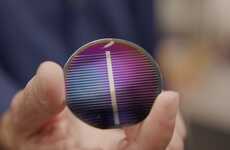
This Technology Produces Solar-Powered Fuel with Zero Emissions
Cadhla Gray — August 25, 2015 — Eco
References: iflscience & abc.net.au
Researchers at the Monash University in Melbourne, Australia have developed artificial leaves which use hydrogen and the power of photosynthesis to produce clean energy. Not only does this technology mimic the natural process of photosynthesis but it actually utilizes the sun’s energy more efficiently than nature itself. The solar efficiency of these artificial leaves is 22%, while the highest efficiency of other solar fuels so far is 18%, and plants come in at only about one or two per cent.
The technology functions by running an electrical current through water, using nickel to separate hydrogen and oxygen, which produces hydrogen fuel -- a clean source of energy that doesn’t give off any carbon emissions.
With the increase of interest in renewable solar energy by the general public as well as private companies like Tesla and Google, this inexpensive and zero-emission technology shows great potential for future fuel alternatives.
The technology functions by running an electrical current through water, using nickel to separate hydrogen and oxygen, which produces hydrogen fuel -- a clean source of energy that doesn’t give off any carbon emissions.
With the increase of interest in renewable solar energy by the general public as well as private companies like Tesla and Google, this inexpensive and zero-emission technology shows great potential for future fuel alternatives.
Trend Themes
1. Artificial Leaves - Artificial leaves that utilize photosynthesis to produce clean energy have the potential to revolutionize renewable energy production.
2. Solar Efficiency - The increase in solar efficiency, as demonstrated by the 22% efficiency of artificial leaves, presents disruptive innovation opportunities for the solar energy industry.
3. Zero-emission Technology - Zero-emission technologies like the artificial leaves developed by Monash University have the potential to disrupt the fuel and energy industries by providing clean and sustainable alternatives.
Industry Implications
1. Renewable Energy - The renewable energy industry can leverage artificial leaves and their efficient solar energy utilization to increase clean energy production and reduce carbon emissions.
2. Solar Energy - The solar energy industry can benefit from the development of artificial leaves that have higher solar efficiency, enabling more efficient solar energy conversion and utilization.
3. Fuel and Energy - The fuel and energy industries have the opportunity to embrace zero-emission technologies like artificial leaves, which can provide clean and sustainable fuel alternatives for a greener future.
5.7
Score
Popularity
Activity
Freshness























